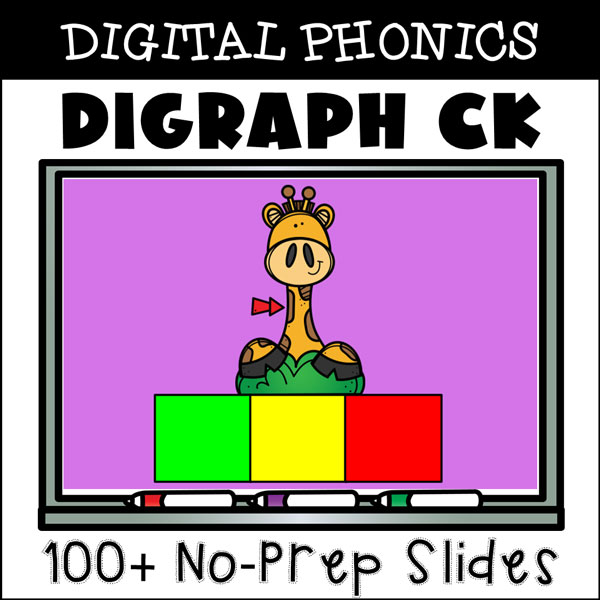Are you wondering how to approach teaching digraph CK? Are you considering to what extent you should explain the rules for using CK in spelling words?
Many students pick up on the proper usage of digraph CK almost immediately. They do it with little direct instruction at all. You may have been one of those students yourself.
It’s no surprise, however, that other students won’t catch on so quickly. Will explaining the rules help them, slow them down, or cause more confusion?
In this article, I’ll share my perspective on teaching rules in structured literacy, with specific focus on the CK digraph. I’ll also share my suggestions for introducing the CK sound-spelling correspondence and some of my favorite activities for practice. This practice includes application at the word, sentence, and passage level. If you want to skip ahead to get these CK resources, feel free to click here.
The Rules Debate
There’s been a bit of debate going on lately about ditching the rules when teaching children to read and write. Some claim that rules burden the brain and are unnecessary in teaching children to read. Others believe that their students need to understand the rules in order to make progress. I wouldn’t call it another “reading war”, but I’ve been hearing a lot of disagreement and discussion, and it’s got me thinking about my own teaching.
As a kid, did anyone teach me the rule about when to use ck or k in spelling the /k/ sound at the end of a word or syllable? Nope.
Did I learn to read and write just fine without learning most of the phonics rules that explain how the English language works? Yep.
BUT…
I probably fell into the top category of Dr. Nancy Young’s ladder and would’ve learned to read and write no matter what my teachers did. That’s just the brain I was born with; I didn’t do anything to earn it. I hear other adults say, “Nobody taught me these rules and I can read and write very well.” Again, these are likely those top of the ladder people for whom reading comes easily.
But what about the rest of the kids? What about the 85-95% of students who would either likely benefit from or absolutely require more explicit instruction?
These are the kids I’m most concerned about. They’re the kids I’ve spent the majority of my career teaching. These are the children who NEED the reading and spelling of English to make some kind of sense. And these are the students that will require many repetitions and opportunities to practice the application of these rules, with immediate corrective feedback, before they’ll be able to read and write with success.
Rethinking the Idea of Rules
Should we even call them rules?
Some educators prefer the term generalizations or patterns when introducing a new sound-spelling correspondence. The thinking is that if we refer to the concepts as rules, then we’ll have to get into all the “rule-breakers” and exceptions. However, if we call them patterns, it implies a little more flexibility.
Honestly, I don’t think the term we use matters much to kids. They know that sometimes rules are not followed. What matters is that we help them see that English can make sense (mostly).
With that said, there are some programs that I think go overboard with the rules. Reciting lengthy rules taxes working memory and causes cognitive overload in many at-risk readers. For that reason, I prefer to keep the explanation of rules simple. I tell my kids the rule, give a few familiar examples and then lots of practice! Throughout the process, I ask my kids questions to give them an opportunity to explain the rule back to me or to their classmates.
Helping students understand the CK rule will potentially unlock hundreds of new words for them. Take a peek at this list if you are curious to see just how many words there are!
For the purposes of beginning instruction, I compiled two word lists below that you can use in your lessons. The first one has only 3-sound words without blends and/or other digraphs. The second one contains 3-and 4-sound words with blends and other consonant digraphs such as CH and SH.
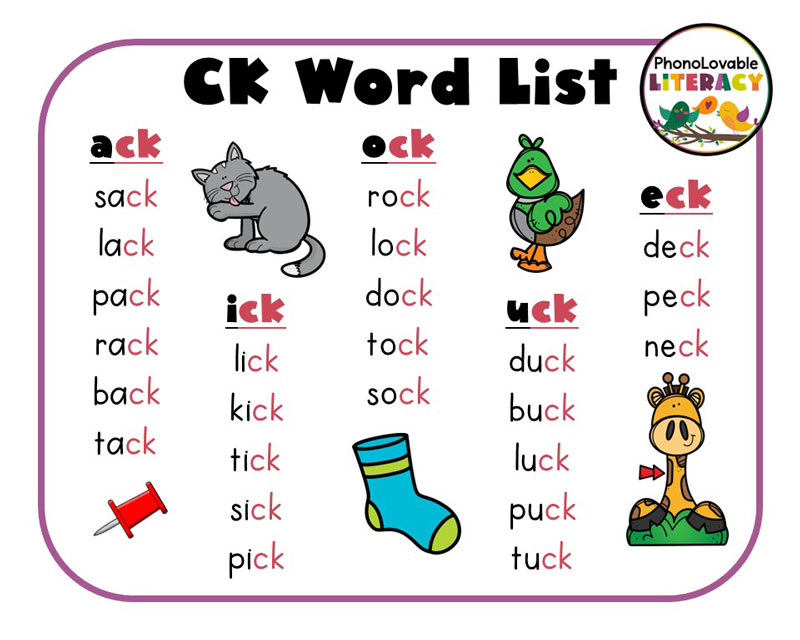
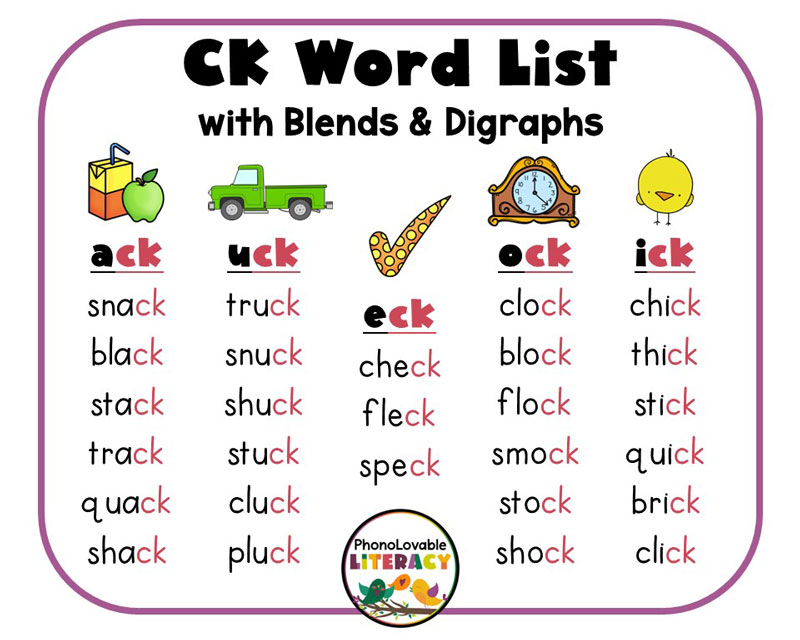
How Can We Teach Digraph CK?
With the idea of keeping it simple in mind when explaining phonics rules, here’s how I teach digraph CK in a clear and engaging way.
As soon as I introduce the concept of vowels to my students, we practice saying the long and short sounds. I tell them that sometimes vowels sound like their names “A-E-I-O-U”. We call these the long vowel sounds. In contrast, sometimes vowels sound different like /a/ as in apple, /i/ as in itch, /e/ as in edge, /u/ as in up, and /o/ as in octopus. We call those the short vowel sounds.
Why bother introducing both sounds early?
Imagine spending weeks or months in Kindergarten or First Grade only being exposed to the short vowel sounds. For example, every day you hear your teacher say that A makes the /a/ sound like apple, and your name is Jason or Stacy. Imagine how confused Jason and Stacy might be, wondering why their names don’t make sense.
Students understanding the difference between long and short vowels upfront will eliminate confusion when students encounter the long vowel sound in other contexts. Without getting into the actual decoding and encoding of the long vowels yet, but just letting them know that they exist, helps ease some of that confusion. It also may help prevent the “English makes no sense” misconception that a lot of us still have.
So when it comes to introducing the digraph CK rule, having that foundation of what a short vowel is sets students up for success.
Start with Speech First
Like with most new concepts, we start learning about digraph CK by paying attention to our speech. First, with no print in sight, I ask students to repeat words such as stack, lick, rock, neck, and truck, showing visuals for added interest.

After I ask students to say a word, like neck, I tell them to “chop it up”. I have them say each sound as they make a chopping motion on their desks. Sometimes, I have them count on their fingers as they say /n/ – /e/ – /k/. I point to colored magnetic dots on my board as they say each sound. With each word, I draw attention to the fact that the /k/ sound is coming directly after a short vowel sound.
Show Digraph CK in Print
Next, I write a few of those words on the board. I ask my students to identify what’s representing that final /k/ sound after the short vowel. When students make the connection that it’s the letters CK together, I underline the ck in each word. Then, we read all of the words chorally.
At this point, I pull out a embedded mnemonic card with the letters CK and a keyword/picture sock.
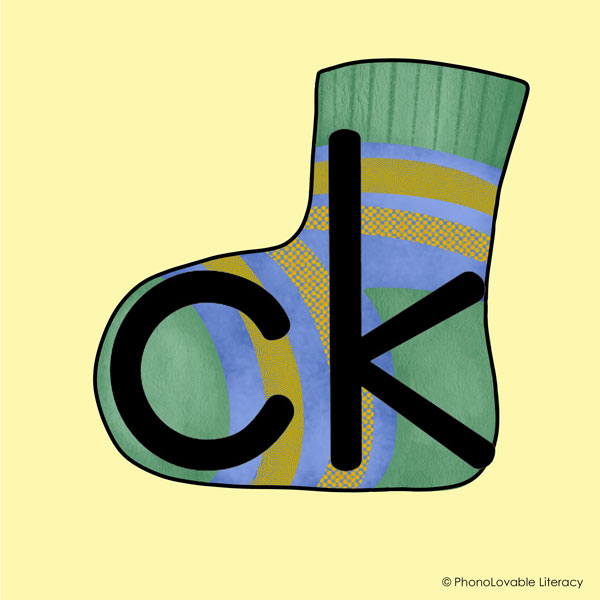
If you need embedded cards, you may get them for free here.
To learn more about this guided discovery, or speech-to-print, method of introducing a new sound-spelling correspondence, I explain it in greater detail in this article about teaching digraph SH.
Digraph CK is usually the first consonant digraph I teach because it’s the easiest for kids to remember. Since they’ve already made the connection between the sound /k/ for the letters c (as in cat) and k (as in kid) individually, it’s not a stretch for them to understand that putting them together makes the same sound.
Also, I tell them that we don’t say the /k/ sound twice, just once, and that two letters making one sound is called a digraph.
Pointing to one of the words, like neck, I’ll say, “We don’t read this as neck – k – (saying it with a double /k/ – /k/ sound at the end). I have a pain in my neck-k. That sounds silly.” This usually leads to other silly examples, “I need to scratch my back-k”, etc. This gets the point across that we only need to say the /k/ sound once.
Finally, I’ll sum up the rule and ask students to explain to a friend when we use the letters ck together when spelling. This shows me if they were paying attention and really understand what I just taught.
Is Explicit Instruction Really Necessary?
Since the digraph CK seems like such an easy concept, is it really necessary to teach it so explicitly?
Years ago, I taught a group of students the CK digraph. After the lesson, I was feeling pretty good about myself because they appeared to understand what I taught them. They could explain that we use CK with short vowel words. The next day, I noticed that one student was writing ck at the beginning of words. Then I saw yet another student write it after consonants, in the words desck and milck. Oops!
I clearly wasn’t explicit enough. I failed to mention some important parts of the CK rule. So later that day, I explained that the CK ONLY comes AFTER the vowel and also NOT after a consonant. If we hear the /k/ sound at the end of a 1 syllable word, but we hear a consonant or a long vowel sound right before it, then we will use the letter k, NOT the digraph ck.
This reminded me about the importance of not only rules, but the need to be explicit with examples and nonexamples.
Practice, Practice, Practice
Typical learners may only need a few exposures to a rule/pattern with a handful of opportunities to practice its application. However, it’s the more at-risk readers (with dyslexia or other reading and spelling challenges) who I am most concerned about. These students need MANY MORE opportunities to solidify their understanding.
They need to practice decoding and encoding words, receive lots of corrective feedback, read decodable sentences, write dictated controlled sentences, and read decodable books or passages before the digraph CK will become effortless for them. This may take days or weeks, depending on your students and their unique needs.
Some Digraph CK Practice Activities
If you need more effective, engaging practice activities for your students to master the CK digraph, I hope you’ll check out some of the resources below.
Complete Structured Literacy Lesson with NO-PREP Slides: This digital resource has everything you need to effectively teach digraph CK in an engaging way. You may spread the lesson out over several days or weeks, depending on the needs of your students. Introduction of the CK digraph with real photographs, an embedded mnemonic, word decoding slides with visuals provided AFTER students read the word, spelling practice, decodable sentences, sentence dictation, hidden “mystery” picture word chains (a student favorite!), and additional phonemic awareness practice are all included in over 100 animated, done-for-you slides.
Use these slides on their own, or pair them with the FREE “Print & Go” pages for additional practice and reinforcement of the skills.
Concept Page & Word Lists: This free printable comes with an embedded mnemonic with the keyword “sock” and two differentiated word lists. If your students have binders, this makes a good page to give out at the end of your first lesson.
Word Ladders: Word chains provide efficient and effective practice of a new skill. This free printable provides three pages of encoding (spelling) practice in the form of word ladders. Black-and-white as well as color versions are provided, with and without lines for phoneme segmentation.
Games: Some students need multiple opportunities to practice reading CK words. Games are a great way to provide this varied practice in a fun way. Tic-tac-toe and bingo pages with basic and advanced CK words are included.
Decodable Sentences: Two differentiated pages of decodable sentence practice are included. Students may highlight all of the CK words, practice reading for accuracy, and scoop phrases to help with appropriate expression and fluency. Teachers may use the blank boxes next to each sentence to make a checkmark or place a sticker in each time a sentence is read.
Decodable Story: This free printable passage contains multiple versions for differentiation and varied practice. For example, students may underline all of the CK words, read the story to a partner or with the teacher, illustrate the story, or practice reading the passage for accuracy or fluency.
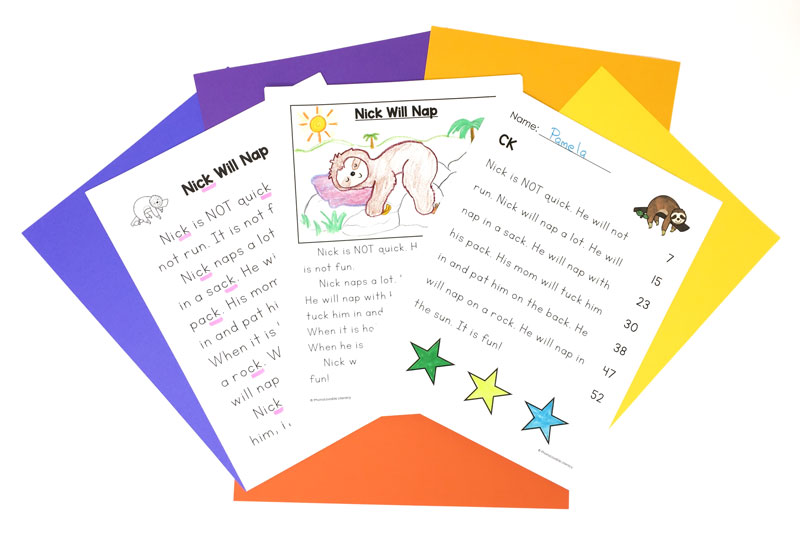
Final Thoughts
Whether structured literacy is new to you or you’ve been teaching this way for years, I hope I was able to give you a few ideas and activities to help your children (especially those who need explicit instruction the most) master the CK digraph. A little bit of rules instruction and meaningful practice will go a long way as your students gain confidence in their reading and writing. I wish each of you feelings of joy and success on your journey.


